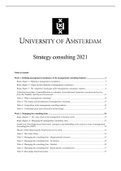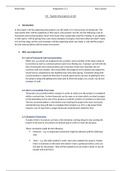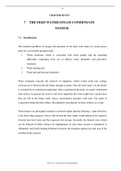a Real Firm
3939 unread replies.6969 replies.
Our discussion topic concerns the calculation of stock values using the capital asset
pricing model (CAPM). Explain the CAPM model. The textbook provides a list of betas
for a selection of stocks. Choose two firms from that list and discuss whether the betas
are what you would expect. Be sure to explain why or why not. Calculate the returns
based on the CAPM model. Be sure to state your assumptions.
**For full credit reply to the prompt and to another student's response. You should have
two postings for your 20 points.
o Collapse SubdiscussionAlina Bell
Alina Bell
Jan 31, 2021Jan 31 at 3:26pm
Manage Discussion Entry
The CAPM model is widely used in finance and it is based on the idea that riskier
investments should earn higher returns. The expected return is what the investor
expects to earn from an investment over the lifetime of the investment. The risk free
rate is the equivalent of the yield of a 10 year US Government bond. Beta represents
the stock's risk; it is a numerical value that quantifies how susceptible the stock is to
changes in the market. If a stock’s risk outpaces the market, its beta is more than
one. If its beta is less than one, it can reduce the risk within a diversified
portfolio. The market risk premium is the the additional return an investor expects to
receive from holding a risky market portfolio instead of risk-free assets.
The formula is: Expected return = Risk-free rate + (beta x market risk premium)
According to https://www.zacks.com/stock/chart/ADBE/fundamental/beta, (Links to
an external site.) Adobe, Inc. has a beta of .98. Since this number is less than 1, it
indicates that Adobe, Inc. stock is less volatile than the market, but not by much. I
would say it pretty much moves with the market.
ADBE : E(r) = 1.11% + 0.98X3.778% = 4.812
The expected return for investments in Adobe, Inc. stock is 4.812%
https://smartasset.com/investing/capital-asset-pricing-model (Links to an external
site.)
https://ycharts.com/indicators/10_year_treasury_rate (Links to an external
site.) (source for risk free rate today)
, http://www.market-risk-premia.com/us.html (Links to an external site.) (source for
market risk rate - available for 12/31/2020)
Read More
Reply Reply to Comment
Collapse SubdiscussionCamiesha Harmon-Askew
Camiesha Harmon-Askew
Feb 1, 2021Feb 1 at 10:47am
Manage Discussion Entry
Alina, great explanation. The capital asset pricing model (CAPM) is a model used
to determine a theoretically appropriate required rate of returnof an asset.The model
takes into account the asset's sensitivity to non-diversifiable risk (also known as
systematic risk or market risk), often represented by the quantity beta (β) in the
financial industry, as well as the expected return of the market and the expected
return of a theoretical risk-free asset.
Reply Reply to Comment
Collapse SubdiscussionLynnsey Candella
Lynnsey Candella
Feb 6, 2021Feb 6 at 1:09pm
, Manage Discussion Entry
Alina,
Great explanation of capital asset pricing model. This is a term that I have never
heard until this week. After learning about it and reading everyone's post, I think that
this is something that if used, could be extremely helpful. I would agree with you that
Adobe, Inc moves with the market.
Reply Reply to Comment
Collapse SubdiscussionRussel Jankovik
Russel Jankovik
Feb 7, 2021Feb 7 at 5:11pm
Manage Discussion Entry
Hello Alina,
I like how you explained this question very thoroughly. Having never gone to the
Zacks page before it was a bit confusing, but I like how you gave an example of a
company you looked at. I now understand what you mean what you say that while
Adobe slightly less volatile than the market, it still pretty much moves with the
market. Now I've gone and looked at several more and notice that about each one.
Reply Reply to Comment
o
Collapse SubdiscussionAmber Conrad
Amber Conrad
Feb 2, 2021Feb 2 at 2:21pm
Manage Discussion Entry
Professor/Class,
, In reading through this week's reading assignments, I learned that CAPM identifies
the risks of assets as its contribution to risk of a well-diversified portfolio.
Diversification does not eliminate market risks however, investors are compensated
for bearing the risks.
A stock's beta coefficient helps quantify how much risk a stock contributes to a well-
diversified portfolio.
In utilizing:
https://www.zacks.com/stock/chart/AMZN/fundamental/beta
I chose to evaluate Abercrombie & Fitch. Abercrombie has a beta of 1.82. Since this
value is greater than (1), we know that the stock is more volatile than the broader
market.
For the US economy, assuming rf = 1.5% and rm - rf = 4.9% (Source : Market-Risk-
Premia.com), we calculate an expected return of 13.4%:
ANF: E(r) = 1.5% + 1.82 X 4.9% = 13.377%
Reply Reply to Comment
Collapse SubdiscussionKegan Brown
Kegan Brown
Feb 3, 2021Feb 3 at 6:15am
Manage Discussion Entry
Amber,
Excellent break down, it is interesting to see your calculations on Abercrombie &
Fitch. I am actually surprised this company is still a brick and mortar, it seems like a
lot of these have been failing and i am surprised it does not have a higher beta. I
can assume that it is higher because of the Corona virus as well, but it is interesting
how certain issues effect stores like these. Do you think there would be a clothing
store that is worth the investment? I feel that buying clothes has been more of an
online commodity ]for me and my family, its super easy to return on Amazon and
you can find cheaper selections for similar clothes. When i was younger having
some of these brand name clothes set you apart from the other kids, now it seems
like dressing cheaply is the way to go. My oldest child is in middle school and i have





